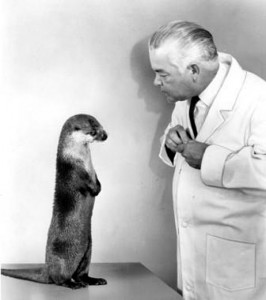Training with food will make your dog beg from the table — No, feeding your dog from the table will make your dog beg from the table, and feeding your dog from the couch will make your dog beg while you are on the couch. Feeding your dog after he does a specific behaviour (like “Sitting”) will make him do that behaviour more often to get the food! Isn’t that the essence of training? An important part of Clicker Training is getting the dog to understand that he gets his food reward after offering the desired behaviour and earning his “click” from the trainer.
 Clickers and Clicker Training are just gimmicks, fads someone dreamed up — The first clicker was used by Keller Breland in his animal training in the 1950s. Marian and Keller Breland’s company, Animal Behaviour Enterprises,
went on to become one of the most successful animal training companies
ever, from 1955 to the mid-1980s. The principles of Clicker Training
have been used in marine mammal training at animal parks and even in
government projects since the 1960s.
Clickers and Clicker Training are just gimmicks, fads someone dreamed up — The first clicker was used by Keller Breland in his animal training in the 1950s. Marian and Keller Breland’s company, Animal Behaviour Enterprises,
went on to become one of the most successful animal training companies
ever, from 1955 to the mid-1980s. The principles of Clicker Training
have been used in marine mammal training at animal parks and even in
government projects since the 1960s. Karen Pryor brought Clicker Training into the public eye in 1984 with her book Don’t Shoot the Dog. In 1987, she began offering seminars on how to Clicker Train animals. The work of Karen Pryor and many others has helped Clicker Training grow in scope and popularity. Today, clickers are available at nearly every pet store and there are dozens of books on how to Clicker Train dogs, cats, birds, horses — and even people — to do amazing things. Clicker Training has been around for more than 60 years. It’s no fad!
If you use Clicker Training, your dog won’t work without the clicker or the food rewards — Every Clicker Training book contains clear and detailed instructions for fading out the use of both the clicker and the food rewards as part of the standard training method. Anyone who tells you that either the clicker or food rewards must be present or a Clicker Trained dog won’t perform simply doesn’t understand the basics of Clicker Training. A clicker is most useful when introducing a new behaviour to a dog. It provides a clear and precise signal for what behaviour is earning the reward. When your dog is learning a new behaviour, food rewards provide a strong incentive to play what amounts to a guessing game with the trainer. Once the behaviour becomes well known, the need for the precision of the clicker and the motivation of the food reward diminishes rapidly.
Clicker Training is unhealthy because food treats will make your dog fat and he will beg for treats — Here’s a fact for you: all dogs eat, usually every day. Eating is not unhealthy. Clicker Training books advocate that trainers use quality food rewards in very small portions (often pellet-sized bits) so the dog can do many repetitions with consuming a lot of extra food. Those same books also advise that the dog’s meal sizes should be decreased to accommodate for the treats delivered in training. A Clicker Trained dog should eat no more in a day than he would if he were not training. Since Clicker Training teaches the dog that behaviours are necessary before the “click and treat” will happen, it’s more likely that the dog will beg for more training than beg for food.
AVES MADUREIRA ADESTRAMENTO - TREINO DE AVES AVESMADUREIRA
MAIS INFORMAÇÕES: AVESMADUREIRA@HOTMAIL.COM TREINO ESPECIALIZADO PARA AVES.